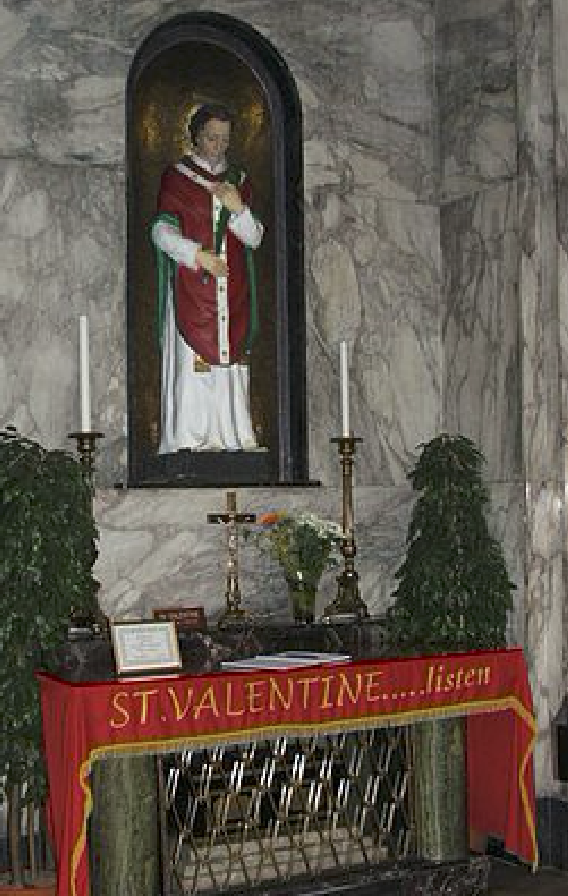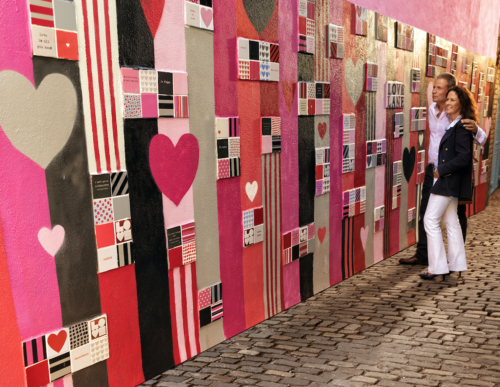Valentine’s Day Remains
by Alison Benney
Going somewhere romantic for Valentine’s Day?
Try Dublin, where the patron saint of romance resides – at least, a few relics of him – in Whitefriar Street Carmelite Church.
Saint Valentine, the symbol of romantic love, was a priest in the third century and one of the many early Christian martyrs. But are these relics authentically his? The name was not uncommon; a bouquet of almost 40 other Saint Valentines are listed in the Biographical Dictionary of Saints, including three women, one 40-day pope, and a close competitor in Terni, Italy, who is the patron saint of epilepsy.
Most sources agree that Dublin’s St. Valentine is probably the one about whom Roman Martyrology reports: « After performing many miraculous cures and giving much wise counsel, he was beaten and beheaded » on 14 February, 269 A.D. (note to baby-boomers: exactly 1,700 years before the Summer of Love).
According to legend, Valentinus’ martyrdom was due to sanctifying illegal weddings, flouting the edict of Emperor Claudius II who believed that bachelors made better soldiers and so forbade young men from marrying. After other defiant acts of Christianity, including trying to convert the emperor himself, Valentine was arrested and thrown into a Roman jail. While there, he allegedly healed the blind daughter of a judge, to whom he signed his farewell letter « from your Valentine. »
Yet it wasn’t until the 14th century that the medieval custom of exchanging love notes was first recorded by Chaucer in his « Parliament of Foules. » According to Wikipedia, the earliest surviving valentine is a 15th century rondeau written by Charles, Duke of Orléans, to his wife, called “A Farewell to Love,” which starts out:
Je suis desja d’amour tanné,
Ma tres doulce Valentinée…
Of course, one could also do a romantic pilgrimage to Rome, as traces of St. Valentine remain; for instance, you can see the flower-crowned skull of St Valentine in the Basilica di Santa Maria in Cosmedin; visit the Gate of St. Valentine, now called Porta del Popolo; descend into the Catacombes de Saint- Hyppolyte, or enter the ruins of the church of St. Valentine on via Flaminia, where he was beheaded.

St. Valentine’s remains have also traveled to Madrid, where his relics can be seen at St. Anton’s Church, or to Prague in the Basilica of St. Peter and St. Paul, as nearby as Belgium in the Église Saint-Valentin-de-Rome, in Montignies-sur-Sambre, or as far away as the Greek island of Lesbos.
If travel is not an option, stay home and watch an old movie with the 1920s Hollywood heartthrob, Rodolfo Guglielmi di Valentina d’Antonguolla, better known as Rudolph Valentino. Did you know that the modern-day fashion designer Valentino was named for the film star? Plus, his signature red dresses have become known in the fashion industry as « Valentino red. »
So how did St. Valentine’s relics arrive in Dublin? Thanks to a gesture of appreciation in 1836 from Pope Gregory XVI to an inspiring Irish priest, Father John Spratt, some of the remains of St. Valentine were disinterred from the Saint Hippolyte Cemetery on Tiburtine Way in Rome, and transferred in a reliquary to Father Spratt’s church in Dublin. And on the 14th of February each year the priest at Whitefriar Street Church offers couples a blessing of the rings, “for those who are about to get married and those who have been married for some years.”
So move over, St. Patrick, St. Brigid, St. Brendan – Saint Valentine has a touch of Irish, too. And with good reason: after all, aren’t all blushing hearts tinged with a bit of jealous green?

